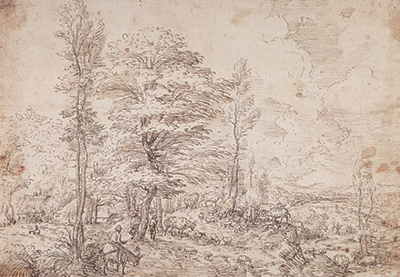This fairly simple piece captures the beauty of the European landscape and allows Pieter Bruegel the Elder, it's creator, to display his own impressive technical ability.
The style found here is entirely consistent with many other landscape drawings completed by Bruegel during his career, as well as the designs that he put forward for engravings that would later be printed. We see a few figures in the foreground but more of the scene is devoted to nature, and Bruegel would normally leave people out of this medium. It was only in his paintings where his landscapes would also feature large numbers of local people, as seen in the likes of Hunters in the Snow, Netherlandish Proverbs and Census at Bethlehem. He would often add particularly subtle cloud systems to his skies which supported the rest of the composition, rather than adding anything significant. Bruegel decorates his trees with elaborate detail here, leaving these as the main focal point within this piece whose title translates as Pastoral Landscape.
Brown ink pen was used on paper to produce this piece. It is dated at 1552, as illustrated by the date left by the artist alongside his own signature at the bottom of the drawing. A shield watermark was also added, probably at a later date, in order to confirm the authenticity of Bruegel's involvement. It is now owned by the Nasjonalgalleriet in Oslo, Norway. This city will always remain most famous for its display of Edvard Munch's paintings within the specialist Munch Museum, but other artists are also featured here within a number of galleries and museums found elsewhere in the city. Bruegel remains one of the biggest names of the Northern Renaissance and so all major galleries will be keen to add some of his work to their collections, often having to look beyond his more famous paintings because they will never likely become available, ensuring a great interest in other mediums such as his drawings or etching designs.
The Nasjonalgalleriet in Oslo, which translates as the National Gallery, is well worth a visit for those fortunate enough to find themselves within this beautiful city. The Scream, 1893 by Edvard Munch remains the biggest draw here, naturally, but you can also find Claude Monet (Rainy Day, Etretat) as well as other paintings from the likes of El Greco, Lucas Cranach the Elder, Orazio Gentileschi and his talented daughter, Artemisia Gentileschi, as well. This city as a whole is a real culture spot and adds an extra dimension for those considering a long weekend in this picturesque part of Northern Europe. It would be hard to find many more significant collections within Scandanavia than the one found within the Nasjonalgalleriet.




